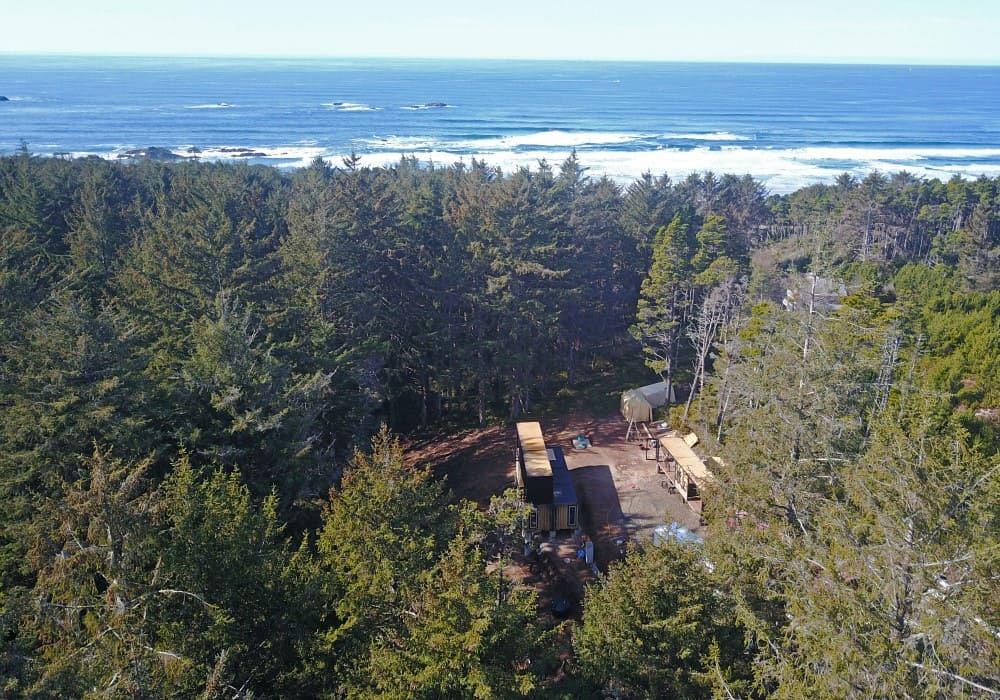- FMA
- The Fabricator
- FABTECH
- Canadian Metalworking
Categories
- Additive Manufacturing
- Aluminum Welding
- Arc Welding
- Assembly and Joining
- Automation and Robotics
- Bending and Forming
- Consumables
- Cutting and Weld Prep
- Electric Vehicles
- En Español
- Finishing
- Hydroforming
- Laser Cutting
- Laser Welding
- Machining
- Manufacturing Software
- Materials Handling
- Metals/Materials
- Oxyfuel Cutting
- Plasma Cutting
- Power Tools
- Punching and Other Holemaking
- Roll Forming
- Safety
- Sawing
- Shearing
- Shop Management
- Testing and Measuring
- Tube and Pipe Fabrication
- Tube and Pipe Production
- Waterjet Cutting
Industry Directory
Webcasts
Podcasts
FAB 40
Advertise
Subscribe
Account Login
Search
Off the Grid: 5 challenges of building off the grid with shipping containers
From planning around natural resources to the availability of building materials
- By Jessica P.
- June 6, 2021
Two years ago my husband Vaillant and I began a journey of building our dream house out of steel shipping containers along a mostly remote stretch of the Pacific Ocean coastline in Oregon (a place we’ve deemed Pacific Pines Ranch). We went into this massive project with very little building or metal fabrication experience. And, on top of that, we have been constructing off the grid.
With that said, here are five of the most significant challenges we’ve faced while building our shipping container house off the grid.
1. Reliance on nature
When building off the grid, nature will dictate the resources available. Water and electricity depend on what nature provides and how it can be harvested. Electricity can be derived from water, wind, or solar. Water system efficiency depends on the amount of water nature has provided: Less flow makes it difficult to obtain power. Solar systems depend on sunlight: Less sun means less power is available to charge the system. The same holds true for wind systems. There is a need to plan around the weather/resources if the power source is limited or to have a good-sized generator. Overall, building off the grid requires a good measurement of input versus output to make sure the electrical systems aren't depleted.
2. Delivery/access
Sloped or unpaved roads and weather conditions greatly influence the size and weight of deliveries. For example, it is very difficult to get a full-size concrete truck down a sloped, unpaved road, so this affects what can be built and how. If the land is located where there is only water access, what can be built is limited by what can get to the building site via boat. Overall, the access determines what materials can make it to the site. Concrete, steel, large-sized wood, septic tanks, and other large materials have to be considered and planned before starting the build.
3. Product availability
Specific products or building materials can be hard to find, depending on how far the building site is from a local hardware store or town. Replacement and repair parts also can be hard to find. This means that if something breaks or there is a specific product needed, it takes longer to acquire than if the building site were located near a more populated area. Also, the electrical systems determine what type of power tools can be used. If the tools require a lot of electricity and the system is limited, a generator will be needed. Another factor that comes in is internet access. With no internet available, it is extremely difficult to order items online. All of these factors determine the type of construction that can be done on-site and the tools and products needed for the construction.
4. Resources determine all
The resources available to develop water and electricity will determine everything about the build. Larger systems are more expensive to build and maintain and require a larger amount of resources available (stronger water flow for hydro, larger turbine for wind, etc.). The entire systems need to be developed around the resources. Also, the type of construction needs to be thoroughly thought out to make sure it is within the system’s ability. A general necessity of building off the grid is to have a backup system should the main system fail.
5. Creative solutions
Hired help can be limited or even nonexistent, and building off the grid usually requires a lot of DIY fabrication work. Most of the time it involves a “make do with what you have” attitude and forces you to come up with creative solutions to problems. Lifting heavy materials, transporting items to another area of the building site, and repairing broken items all come with new perspective since access to help, replacement parts, and equipment is hard to acquire.
subscribe now

The Fabricator is North America's leading magazine for the metal forming and fabricating industry. The magazine delivers the news, technical articles, and case histories that enable fabricators to do their jobs more efficiently. The Fabricator has served the industry since 1970.
start your free subscriptionAbout the Author
- Stay connected from anywhere

Easily access valuable industry resources now with full access to the digital edition of The Fabricator.

Easily access valuable industry resources now with full access to the digital edition of The Welder.

Easily access valuable industry resources now with full access to the digital edition of The Tube and Pipe Journal.
- Podcasting
- Podcast:
- The Fabricator Podcast
- Published:
- 04/16/2024
- Running Time:
- 63:29
In this episode of The Fabricator Podcast, Caleb Chamberlain, co-founder and CEO of OSH Cut, discusses his company’s...
- Trending Articles
Tips for creating sheet metal tubes with perforations

Are two heads better than one in fiber laser cutting?

Supporting the metal fabricating industry through FMA

JM Steel triples capacity for solar energy projects at Pennsylvania facility

Omco Solar opens second Alabama manufacturing facility

- Industry Events
16th Annual Safety Conference
- April 30 - May 1, 2024
- Elgin,
Pipe and Tube Conference
- May 21 - 22, 2024
- Omaha, NE
World-Class Roll Forming Workshop
- June 5 - 6, 2024
- Louisville, KY
Advanced Laser Application Workshop
- June 25 - 27, 2024
- Novi, MI




























